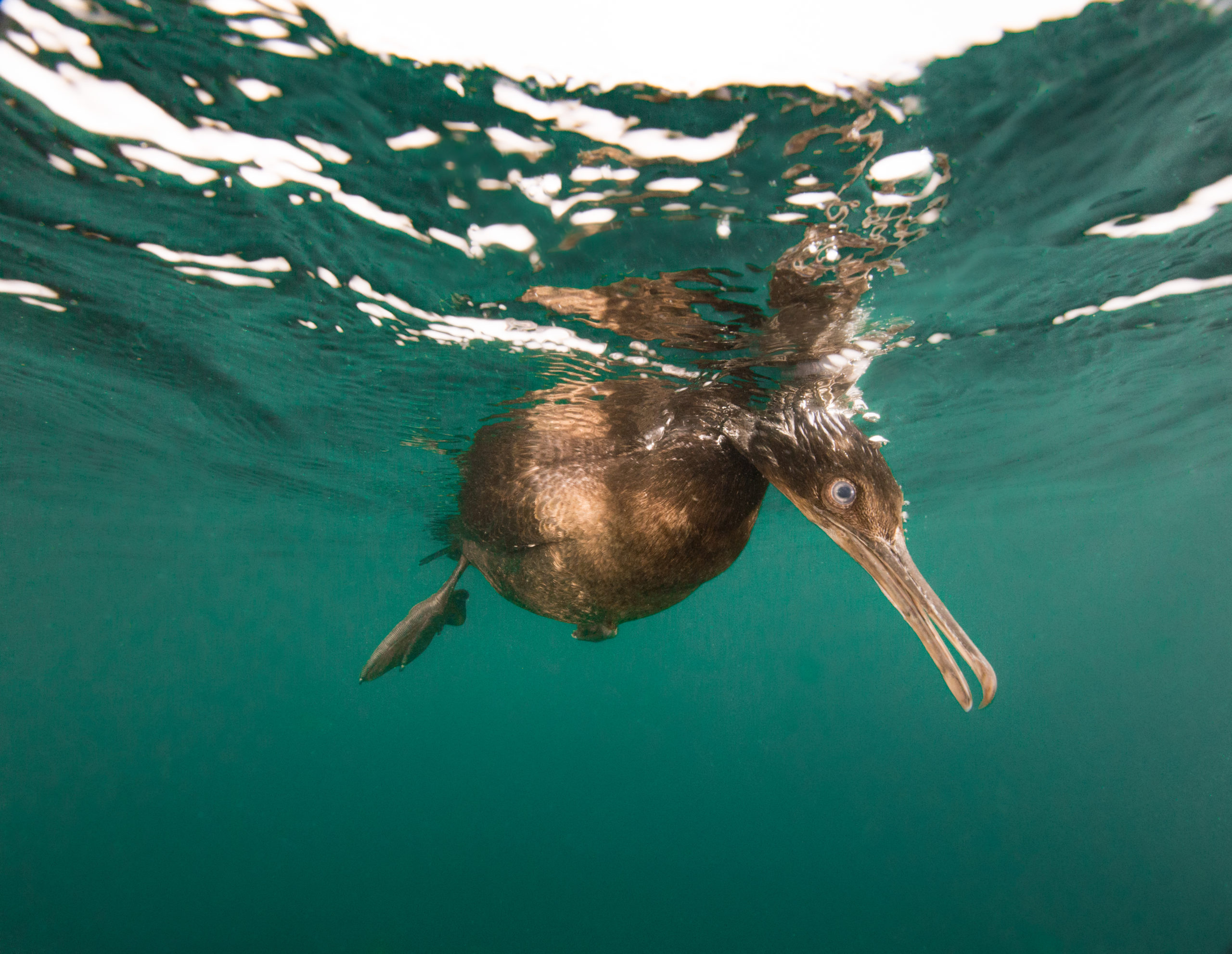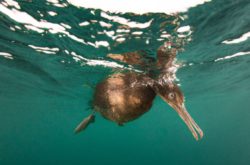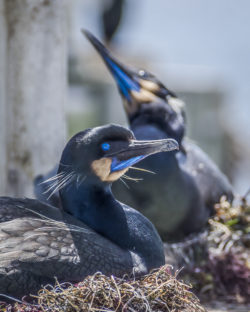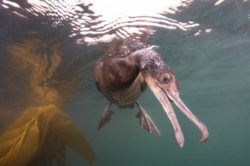
Sea Wonder: Brandt’s Cormorant

Brandt’s Cormorant in Monterey Bay National Marine Sanctuary. Photo: Curtis Wee
Named after Johan Friedrich von Brandt, the German zoologist that first documented the species, Brandt’s Cormorant (Phalacrocorax pencillatus) is a marine bird found only along North America’s Pacific coasts. Brandt’s Cormorants are the largest cormorant species on the Pacific coast and are well adapted to life on land, in air, and even underwater for short periods of time.
Description
Brandt’s Cormorants are large and heavy-bodied birds with long, skinny necks and ovular bodies. Both sexes are similar in size, measuring lengths between two and three feet, weighing three to six pounds, and with wingspans that reach nearly four feet across. Juveniles have a brown plumage covering their bodies, with a lighter shade covering their necks and breast, creating a V shape pattern. Adults look much different, marked by black plumage with a purple tint, white, whiskery feathers on the head, neck, and shoulders, and, during early breeding season, bright blue skin patches on their throats. Their bills are fairly long in proportion to the rest of the body with a hooked tip at the end. Their tails are medium in length, their legs short, and their feet webbed.
Diet & Habitat
Brandt’s Cormorants rely on a seafood diet for survival, primarily fish and squid. They hunt underwater, diving from the surface, using their sharp vision to search for prey swimming by. Using their hooked bills, they will chase their prey toward the surface, grab and crush it with their bill, and swallow it headfirst. Fish and squid are not always near the surface, so Brandt’s Cormorants adapted to dive as deep as 230 feet (but usually dive about 40 feet or so on average) and hold their breaths for about three minutes. Oftentimes, they hunt in flocks (that might include other seabirds like pelicans and shearwaters) and prefer to seek out schools of fish to improve their chances of catching one. Sometimes we even see these birds feeding alongside sea lions. Brandt’s Cormorants aren’t picky eaters – scientists and experts have recorded at least 93 species of fish, squid, and the occasional crustacean as prey items, whether by stomach content analysis or observation.
These birds have a range spanning from Alaska to Mexico and are generally year-round residents of their home range but may complete short migrations in response to prey movement. They make their nests on rocky islands and cliffs along the coastline and forage in nearshore areas near upwellings where nutrients move to the ocean’s surface and attract fish. Normally, they don’t stray more than 10 miles inland from the shore unless they are migrating or displaced by human development or activity. Brandt’s Cormorants are found in all five of the national marine sanctuaries on the west coast: Olympic Coast, Channel Islands, Monterey Bay, Greater Farallones, and Cordell Bank national marine sanctuaries. Their primary breeding range between Washington State and Southern California and the Channel Islands near Santa Barbara, CA hosting a critical breeding colony.
Life History

Two Brandt’s Cormorants in nest in Monterey Bay National Marine Sanctuary during breeding season. Photo: Douglas Croft
Highly social birds, Brandt’s Cormorants nest in large colonies and rarely venture off by themselves. Males are responsible for choosing a nesting site and collecting nesting material (sometimes stealing it from other nests) while males and females arrange the materials to their liking, adjusting it constantly while incubating an egg. Nests can be made of plant matter like marine algae, dried grass, moss, sticks, and driftwood, and becoming an increasing pattern in birds is the use of litter – commonly plastics – in creating their homes. Nests can be a little more than a foot across and six inches tall, perfect for incubating between one and six pale blue eggs.
Like many birds, Brandt’s Cormorants practice elaborate mating rituals to select a partner for life. These include dance-like behavior, displays of their characteristic blue throat pouch, and puffing of feathers and fluttering of wings. When females lay eggs, both sexes take turns incubating them so the other can forage. Scientists aren’t sure of the incubation period for Brandt’s Cormorant eggs, but chicks are born featherless and rely on regurgitation feeding by their parents for at least the first month of life. The maximum lifespan for these birds is about 25 years, though the average is closer to 15; they reach sexual maturity at around two years old.
Threats & Conservation
Brandt’s Cormorant populations appear to be healthy but on a slight decline; they are not considered threatened or endangered under the Endangered Species Act and are a Species of Least Concern under the IUCN. The biggest threats to these birds are pesticide use, oil pollution, entanglement in fishing gear, the effects of climate change, and increased human development. During incubation, they are also vulnerable to disturbances from fishing, diving vessels, and shipping, in addition to other tourism activities and increasing urbanization near the coasts.

Brandt’s Cormorant diving in Monterey Bay National Marine Sanctuary. Photo: Curtis Wee
